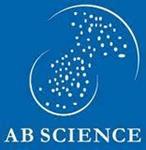PRESS RELEASE
AB SCIENCE PROVIDES INITIAL PHASE 1 DATA FOR THE COMBINATION OF AB8939 WITH VENETOCLAX FOR THE TREATMENT OF REFRACTORY OR RELAPSED ACUTE MYELOID LEUKEMIA
Paris, 16 October 2025, 9pm CET
AB Science SA (Euronext - FR0010557264 - AB) today provides an update on its AB8939 program in acute myeloid leukemia (AML).
The webcast presentation is available on the company’s website, in the section « Press Releases »: https://www.ab-science.com/news-and-media/press-releases/
Highlights of the presentation are the following:
- In monotherapy, AB8939 has shown activity in MECOM, with long OS benefit
- In combination therapy :
- There is a strong rationale to combine AB8939 with Venetoclax, as the combination treatment is well-tolerated and both molecules have different and complementary targets in cancer cells
- The disease control rate is 100% (3/3) and the partial response rate is 100% (3/3), including one patient in complete remission
- These results were obtained after the first cycle of treatment (14 days of treatment) in patients receiving third- or fourth-line treatment, two of whom had previously progressed on venetoclax in combination with other chemotherapies
- Next step is to finish phase 1 in combination and to launch an expansion study in around 15 AML patients eligible to AB8939 + Venetoclax at the right dose
Nicholas J. Short, MD, Associate Professor and Co-Lead of Section of Developmental Therapeutics, Department of Leukemia, MD Anderson Cancer Center, said, "Early data suggest that AB8939 (monotherapy and/or combination) could have significant activity in the highest risk subtypes of AML. If similar responses rates and safety are observed during trial expansion, AB8939 is well-positioned for development in adverse-risk AML in frontline and salvage settings."
Christian Auclair, PharmD, PhD, Professor Emeritus, Cofounder and former director of the PhD program in oncology at Institut Gustave Roussy, Paris-Saclay University, said, "The dual property of AB8939 targeting both cancer cells and cancer stem cells makes AB8939 a molecule of choice for the treatment of high risk leukemia by reducing the frequency of relapses. It is furthermore a perfectly tolerated molecule characterized by a lack of bone marrow toxicity."
Professor Olivier Hermine, MD, President of the Scientific Committee of AB Science and member of the Académie des Sciences in France said, "The fact that the combination of AB8939 and venetoclax exhibits low hematological toxicity is very important as it can allow patients to receive multiple cycles of treatment and maintain a satisfactory quality of life."
Medical need in AML and AB8939 mechanism of action
In AML, there are several registered drugs but 70% of patients relapse and die creating a persistent unmet medical need. AML remains the most lethal leukemia in humans.
AML is a heterogenous disease with outcome highly dependent on genetic factors. TP53 mutation has a very poor prognosis, NRAS, with a median overall survival of 5.5 months. KRAS mutant has a poor prognosis, with a median OS of 12.1 months. MECOM also has a very poor prognosis in AML, with a median OS of 5.5 months in relapsed or refractory setting.
The challenge in AML is the recurrence of tumors due to a combination of two factors: The resistance of cancer cells to chemotherapy and the relapse due to persistence of cancer stem cells. This challenge may be overcome by AB8939 dual mechanism of action.
- First, AB8939 is able to block the proliferation of leukemia cells through microtubules disruption, not being subject to multidrug resistance as it does not bind to PgP, responsible of efflux outside the cells, and not being degraded by the myeloperoxidase enzyme.
- Second, AB8939 targets leukemia cancer stem cells though inhibition of ALDH and favors the bone marrow repopulation of normal progenitors.
AB8939 non-clinical data
- AB8939 has shown in vitro activity in Ara-C (cytarabine is one of the standard of care) resistant patients cell lines, including adverse genetic MECOM, TP53 mutated. Analysis of cell lines responsive to AB8939 shows that AB8939 is effective in cell lines with TP53 mutation, MECOM and complex karyotypes, when ARAC and azacitidine is not effective.
- AB8939 increased survival and has an additive effect in combination with Venetoclax (another standard of care) in vivo in a Mecom grafted PDX mice model.
- AB8939 increased survival and had an additive effect in combination with Vidaza (another standard of care) in vivo in the same Mecom PDX#C1005 mice model.
- AB8939 was able to eradicate Leukemia Cancer Stem Cells in vivo in a human PDX AML mice model, which is compatible with targeting of stem cells via the ALDH.
Clinical data - monotherapy
Phase 1 in monotherapy has been completed and phase 1 in combination has started.
The first two steps of the phase 1, evaluating the maximum tolerated dose (MTD) AB8389 monotherapy after 3 and 14 consecutive days, respectively, have been completed with 28 patients and 13 patients respectively. For both regimen, the MTD was. 21.3 mg/m2.
AB8939 in monotherapy has shown activity in MECOM, based on non-clinical data and early clinical data, with long OS benefit.
Clinical Data – combination therapy
There is a strong rationale to combine AB8939 with Venetoclax
- Both molecules have low hematologic toxicity. This combination is expected to be less toxic than azacitidine + venetoclax as first-line treatment for AML
- Both molecules have different and complementary targets in cancer cells. There is an additive, even synergistic, efficacy potential for the combination, with three mechanisms of action in one treatment.
- Venetoclax mechanism of action is to inhibit BCL2 pathway, a protein that prevents apoptosis (programmed cell death) in cancer cells. BCL2 is a key factor in AML resistance, as it allows cancer cells to survive despite treatment
- AB8939 is pro-apoptotic, destabilizing microtubule, and would benefit from BCL2 inhibition to optimize apoptosis
- In addition, AB8939 specifically targets cancer stem cells by inhibiting ALDH, reducing resistance to treatment and limiting the risk of relapse
In combination, AB8939 + venetoclax remarkably generated responses after the first cycle of treatment in patients in Line 3 or 4 with high risk adverse profile, complex karyotypes, TP53, Mecom and NRAS mutation, respectively. The disease control rate was 100% (3/3), and the partial response rate is 100% (3/3), including one patient in complete remission. Two of the three patients had previously progressed on venetoclax in combination with other chemotherapies.
AB8939 + venetoclax could become a new standard of care in particular for AML patients with adverse genetics
- Venetoclax + Vidaza is the standard of care for aged patient not eligible to high dose chemotherapy in Line 1
- Venetoclax + Vidaza is known to be poorly effective in TP53 and NRAS mutant
- AB8939 preliminary data give credit to the hypothesis that the combination AB8939+venetoclax could become a new standard of care
- AB8939 + venetoclax is less toxic than other combinations, in particular on hema-toxicity
Next steps
The next step is to finish phase 1 in combination and to launch an expansion study in around 15 AML patients eligible to AB8939 + Venetoclax at the right dose. The expansion phase is expected to generate robust preliminary evidence of efficacy in the AML label to support the clinical development plan and beneficial trigger partnership agreement.
There are currently 3 possibilities of registrational studies, not mutually exclusive, that we have started to discuss with FDA and EMA:
- AB8939 + venetoclax in first line of treatment, with aged patients and or adverse genetics (tp53mut + nras + kras + complex k + monosomy 5/7 + mecom)
- AB8939 + venetoclax in second or third line of treatment, all patients or adverse genetics
- AB8939 in MECOM in second or third line of treatment.
Addressable market with AB8939 in relapsed/refractory AML
Treatments in relapsed or refractory AML represent an estimated market size potential above EUR 2 billion per annum.
| Region | Incidence Case (1) | % Relapse or Refractory (2,3) | % Insured Patients (4) | Drug Price (€) | Market Size (per in Mio EUR) |
| USA / CANADA | 23,700 | 50% | 90% | 100,000(5) | 1 000 000 |
| EUROPE | 27,600 | 90% | 60,000 | 770 000 | |
| APAC | 27,800 | 30% | 60,000 | 250 000 | |
| INDIA | 11,000 | 30% | 60,000 | 100,000 | |
| LATAM | 7,200 | 30% | 60,000 | 65 000 | |
| MENA | 3,900 | 30% | 60,000 | 35 000 | |
| TOTAL | 90,200 | 2 200 000 |
EUROPE = EU27 + Norway + United Kingdom + Switzerland ; APAC = Australia, People’s Republic of China , Japan, New Zealand, Singapore, Taiwan ; LATAM = Argentina, Brazil, Chile, Colombia, Costa Rica, Mexico ; MENA = Algeria, Bahrain, Egypt, Israel, Kuwait, Morocco, Oman, Qatar, Saudi Arabia, Tunisia, United Arab Emirates
(1) Zhou, Y et al. Global, regional, and national burden of acute myeloid leukemia, 1990–2021: a systematic analysis for the global burden of disease study 2021. Biomark Res 12, 101 (2024).
(2) Ravandi F. Relapsed acute myeloid leukemia: Why is there no standard of care Best Pract Res Clin Haematol. 2013;26(3):253-9
(3) Walter RB et al. Resistance prediction in AML: analysis of 4601 patients from MRC/NCRI, HOVON/SAKK, SWOG and MD Anderson Cancer Center. Leukemia (2015) 29:312–20. .
(4) Estimated
(5) Choi M. et al. Costs per patient achieving remission with venetoclax-based combinations in newly diagnosed patients with acute myeloid leukemia ineligible for intensive induction chemotherapy. Journal of Managed Care & Specialty Pharmacy Volume 28, Number 9. https://doi.org/10.18553/jmcp.2022.22021
Intellectual property
AB8939 intellectual property rights in AML are secured until 2036 through a ‘composition of matter’ patent and potentially 2041 with the 5 years extension and until 2044 in AML with chromosome abnormality, including MECOM, through a ‘second medical use’ patent.
AB Science is the sole proprietary holder of AB8939 and its family of compounds.
Virtual conference attendees
The following individuals participated in the virtual conference:
- Nicholas J. Short, MD, Associate Professor and Co-Lead of Section of Developmental Therapeutics, Department of Leukemia, MD Anderson Cancer Center
Professor Short is a clinical and translational investigator in adult acute leukemias, with a particular emphasis on the development of phase I and II investigator-initiated clinical trials of novel agents and combinations for patients with acute myeloid leukemia (AML) and acute lymphoblastic leukemia (ALL). His major contributions to leukemia research include: developing new immunotherapy-based frontline regimens in Philadelphia chromosome-negative B-cell ALL, developing chemotherapy-free regimens in Philadelphia chromosome-positive ALL, establishing the clinical utility of high-sensitivity next-generation sequencing-based MRD assays in ALL, developing novel MRD-directed therapies in AML and ALL, and developing novel regimens for older adults with FLT3-mutated AML. He serves as principal investigator or co-principal investigator on over a dozen phase I and II clinical trials and has authored over 250 peer-reviewed manuscripts in the field of leukemia. For his clinical and translational accomplishments in the field of leukemia, he has been awarded the ASCO Young Investigator Award and the ASH Junior Faculty Scholar in Clinical Research.
- Olivier Hermine, MD, PhD, Head of the Hematology Department at Necker-Enfants Malades Hospital, Paris, France
Olivier Hermine is Professor of Hematology at Paris Descartes University, Head of the Hematology Department at Necker-Enfants Malades Hospital, member of LYSA, and Director of the CALYM team "Cellular and Molecular Mechanisms of Hematological Disorders and Therapeutic Implications" at the IMAGINE Inserm U 116 CNRS ERL 8654 institute. He is also coordinator of the Reference Center for Mastocytosis (CeReMast), co-founder and director of the scientific committee of AB Science.
His research topics include lymphoproliferative disorders linked to the hepatitis C virus, mantle cell lymphomas, and the regulation of erythropoiesis. He is the author or co-author of more than 900 scientific publications.
- Christian Auclair, PharmD, PhD, Emeritus Professor
Professor Auclair holds a doctorate in pharmaceutical sciences. He is co-founder and former director of the doctoral school of oncology at the Faculty of Medicine of Paris-Saclay University. He is former director of the biology department at the École Normale Supérieure de Cachan (now ENS Paris-Saclay) and director of UMR 8113 at the CNRS. He was also deputy scientific director of the CNRS's life sciences department. He is the author of more than 120 publications in the field of antitumor pharmacology and virology. He is co-founder and scientific advisor to AB Science.
About AB Science
Founded in 2001, AB Science is a pharmaceutical company specializing in the research, development and commercialization of protein kinase inhibitors (PKIs), a class of targeted proteins whose action are key in signaling pathways within cells. Our programs target only diseases with high unmet medical needs, often lethal with short term survival or rare or refractory to previous line of treatment.
AB Science has developed a proprietary portfolio of molecules and the Company’s lead compound, masitinib, has already been registered for veterinary medicine and is developed in human medicine in oncology, neurological diseases, inflammatory diseases and viral diseases. The company is headquartered in Paris, France, and listed on Euronext Paris (ticker: AB).
Further information is available on AB Science’s website:
www.ab-science.com.
Forward-looking Statements - AB Science
This press release contains forward-looking statements. These statements are not historical facts. These statements include projections and estimates as well as the assumptions on which they are based, statements based on projects, objectives, intentions and expectations regarding financial results, events, operations, future services, product development and their potential or future performance.
These forward-looking statements can often be identified by the words "expect", "anticipate", "believe", "intend", "estimate" or "plan" as well as other similar terms. While AB Science believes these forward-looking statements are reasonable, investors are cautioned that these forward-looking statements are subject to numerous risks and uncertainties that are difficult to predict and generally beyond the control of AB Science and which may imply that results and actual events significantly differ from those expressed, induced or anticipated in the forward-looking information and statements. These risks and uncertainties include the uncertainties related to product development of the Company which may not be successful or to the marketing authorizations granted by competent authorities or, more generally, any factors that may affect marketing capacity of the products developed by AB Science, as well as those developed or identified in the public documents published by AB Science. AB Science disclaims any obligation or undertaking to update the forward-looking information and statements, subject to the applicable regulations, in particular articles 223-1 et seq. of the AMF General Regulations.
For additional information, please contact:
AB Science
Financial Communication & Media Relations
investors@ab-science.com
Attachment







